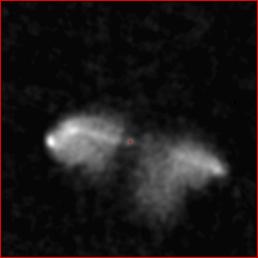 Image:
Image:3C 285 | B1319+428 |
| S178 | Alpha | FR | Class | ID | Spectrum | Best z | mag. | LAS | lg P178 | D |
|---|---|---|---|---|---|---|---|---|---|---|
| 12.3 | 0.95 | II | CD | Gal | 0.0794 | R(c) = 15.47 | 183.70 | 25.09 | 247.2 |

| Size: | 256.0 × 256.0 arcsec² |
|---|---|
| LUT: | Linear |
| Beam: | 5.5 arcsec |
| Frequency: | 1530 MHz |
| Method: | CLEAN Õ˜ÿ>5.5
|
| Telescope: | VLA B+C |
| Credits: | Leahy, Pooley & Riley (1986) |
Tyson, Crane & Saslaw(1977) discovered very faint (B=23.6) optical emission coincident with the compact eastern hotspot, studied in more detail in Saslaw, Crane & Tyson (1978). This may be one of only a handful of hotspots still visible in the optical; unfortunately it is so faint that it has not been possible to test that the optical emission really is synchrotron radiation by looking for polarization or getting a spectrum. An alternative explanation is that this is a chance alignment with a faint galaxy.
Tyson et al. also drew attention to a brighter object (B=20.9) in the middle of the eastern lobe, which they christened 3C 285/09.6. They found it to be probably polarized (9±5%) and speculated that it might be a background quasar. However, when Baum et al (1988) took a narrow-band image to isolate H-alpha at the redshift of 3C 285, /09.6 showed up as well, showing that it is at the same distance. In their detailed study, van Breugel & Dey argue convincingly that 3C 285/09.6 is a starburst, and speculate that it is a case of jet-induced star formation.
The radio structure of 3C 285 is just on the "classical" side of the divide between classical and relaxed doubles. In particular the peak in the western lobe barely counts as a hotspot, while even the eastern hotspot is very weak compared to most hotspots in classical doubles. The lobes are very "fat" (best seen on the C20 image), and tail off to the south, away from the companion galaxy to the north. There is a jet in the eastern lobe, which in van Breugel & Dey's high-resolution image (on our Other Images page) breaks up into a series of four knots, the last and brightest of which marks a sharp bent towards the hotspot. A single very faint knot on the counterjet side (invisible on some browsers) is probably part of a counter-jet.
Our image is a combination of the 1.4 and 1.6 GHz images of
Leahy et al (1986).
| Prev. | Data Page | Other images | Next | Search | Alphanumeric List | Icon List | Atlas Index |
|---|